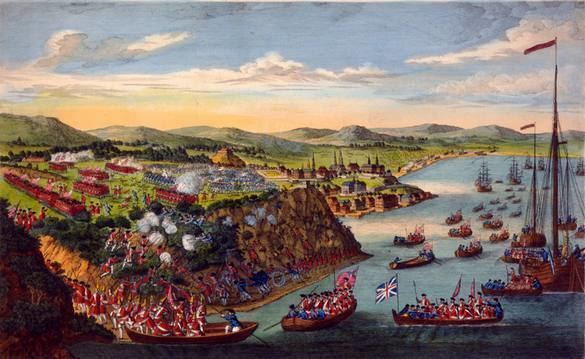Active 1755 to 1881 | Role Infantry | |
 | ||
Size One battalion (two battalions 1804–1815) | ||
The 58th (Rutlandshire) Regiment of Foot was a British Army line infantry regiment raised in 1755. It amalgamated with the 48th (Northamptonshire) Regiment of Foot to form the Northamptonshire Regiment in 1881.
Contents
Early wars
The regiment was raised by Colonel Robert Anstruther as the 60th Regiment of Foot in 1755 for service in the Seven Years' War. It was re-ranked as the 58th Regiment of Foot, following the disbandment of the existing 50th and 51st regiments, in 1756. The regiment embarked for North America in spring 1758 for service in the French and Indian War and saw action at the Siege of Louisbourg in June 1758, the Battle of the Plains of Abraham in September 1759 and the Battle of Sainte-Foy in April 1760. It then moved to the West Indies and, although eight companies of the regiment were captured by the French en route, it took part in the Battle of Havana in summer 1762 during the Anglo-Spanish War. After returning to England later that year it was posted to Gibraltar in 1770 and took part in the Great Siege in the early 1780s. It adopted a county designation as the 58th (Rutlandshire) Regiment of Foot in August 1782.
Napoleonic Wars
The regiment embarked for the West Indies in late 1793 and fought at the capture of Martinique in February 1794 during the French Revolutionary Wars. After returning to England in 1795, it was deployed, under the command of Colonel William Houston, in the Capture of Minorca in November 1798. The regiment then embarked for Egypt for service in the French campaign in Egypt and Syria: it saw action at the Battle of Abukir in March 1801, the Battle of Alexandria later that month and the Siege of Cairo in June 1801. A second battalion was raised in 1804 to increase the strength of the regiment.
The 1st battalion was deployed to Sicily in 1805 for service in the Napoleonic Wars and saw action at the Battle of Maida in July 1806. It then moved to Calabria in Italy, where it participated in a raid on shipping at Diamante in September 1808. It was deployed to Portugal in spring 1812 to serve under the Marquess of Wellington in the Peninsular campaign. During this campaign it fought on the East Coast of the Peninsula at the Battle of Castalla in April 1813 and the Siege of Tarragona in June 1813. It then embarked for North America for service in the War of 1812 and saw action at the Battle of Plattsburgh in September 1814.
Meanwhile the 2nd battalion was deployed to Portugal in April 1812 and saw action at the Battle of Salamanca in July 1812, the Siege of Burgos in September 1812 and the Battle of Vitoria in June 1813. It then pursued the French Army into France and saw action at the Battle of the Pyrenees in July 1813, the Battle of Nivelle in November 1813 and the Battle of the Nive in December 1813 as well as the Battle of Orthez in February 1814.
The Victorian era
The regiment was deployed to Jamaica in 1816 and to Ceylon in 1828 and to New South Wales, where it took over garrison duties from the 80th Regiment of Foot, in 1843. It was deployed to New Zealand for service in the New Zealand Wars in March 1845. In December 1846, during the Wanganui Campaign, 180 soldiers from the regiment and four Royal Artillery men were landed at Whanganui with two 12-pounder guns and began fortifying the town, building the Rutland Stockade on a hill at the town's northern end and the York Stockade towards the south. The establishment of the garrison heightened Te Mamaku's expectations of government intervention, and he vowed he would protect settlers but fight the soldiers. On 16 April 1847, after a minor chief of the Wanganui people was accidentally shot by a junior army officer, about 500 or 600 heavily-armed Māori formed a taua (war party) that swept down the Wanganui River, plundering and burning settlers' houses and killing and mutilating a soldier from the 58th Regiment who ventured out of the town. Although some men from the regiment chose to settle in New Zealand, most of the regiment returned home in 1859.
The regiment was deployed to India in 1864 and remained there until 1874 when it returned to England. It was sent to South Africa in 1879 for service in the Anglo-Zulu War and saw action at the Battle of Ulundi in July 1879. It also fought at the Battle of Laing's Nek in January 1881 and the Battle of Majuba Hill in February 1881 during the First Boer War. At the Battle of Laing's Nek it was the last regiment to carry its regimental colours into battle. Lieutenant Alan Richard Hill won the Victoria Cross at Laing's Nek.
As part of the Cardwell Reforms of the 1870s, where single-battalion regiments were linked together to share a single depot and recruiting district in the United Kingdom, the 58th was linked with the 48th (Northamptonshire) Regiment of Foot, and assigned to district no. 29 at Gibraltar Barracks in Northampton. On 1 July 1881 the Childers Reforms came into effect and the regiment amalgamated with the 48th (Northamptonshire) Regiment of Foot to form the Northamptonshire Regiment.
Battle honours
Battle honours won by the regiment were:
Colonels of the Regiment
Colonels of the Regiment were:
